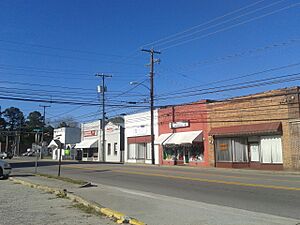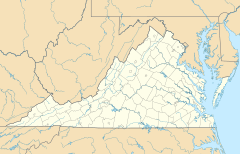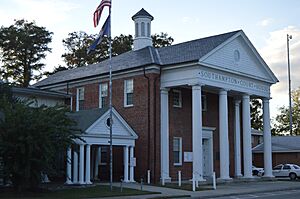Courtland, Virginia facts for kids
Quick facts for kids
Courtland, Virginia
|
|
|---|---|

A view of Main Street in Courtland, Virginia
|
|
| Country | United States |
| State | Virginia |
| County | Southampton |
| Area | |
| • Total | 0.92 sq mi (2.37 km2) |
| • Land | 0.92 sq mi (2.37 km2) |
| • Water | 0.00 sq mi (0.00 km2) |
| Elevation | 23 ft (7 m) |
| Population
(2020)
|
|
| • Total | 1,679 |
| • Density | 1,324.97/sq mi (511.59/km2) |
| Time zone | UTC-5 (Eastern (EST)) |
| • Summer (DST) | UTC-4 (EDT) |
| ZIP code |
23837
|
| Area code(s) | 757, 948 |
| FIPS code | 51-19600 |
| GNIS feature ID | 1498469 |
Courtland is a small town in Southampton County, Virginia, United States. It is the main town and county seat for Southampton County, meaning it's where the local government offices are located.
Contents
History of Courtland
Who Lived Here First?
Long ago, the land where Courtland now stands was home to Native Americans. The Cheroenhaka (Nottoway) and Meherrin tribes lived here. For the first 100 years of the Virginia colony, European settlers were not allowed to live in this area.
In 1677, a peace agreement was signed. It set aside about 41,000 acres (16,592 hectares) for the Nottoway people. They built several villages along the Nottoway River, close to where Courtland is today. Even in 1821, the Nottoways kept their traditional way of life, led by a female leader.
How Courtland Began
In 1749, European settlers created Southampton County from Isle of Wight County. The Blackwater River became the border. In 1751, the county built important buildings like a clerk's office and a prison on the Nottoway River's east bank. A courthouse was added in 1752.
A small town grew around the courthouse. It became a place where people gathered for court and to buy and sell goods. The first courthouse burned down in 1767, and a new one was built in 1768.
Jerusalem: The Town's First Name
In 1791, the Virginia General Assembly officially made it a town called Jerusalem. This was the only town in Southampton County during the 1700s. Eight leaders divided the town's ten acres (40,000 square meters) into smaller lots. They created two main streets: Main Street and the eastern part of Court Street. People bought these lots and had to build a house within five years.
An inn, or "ordinary," was built in 1796 by Henry Adams and Thomas Hunts. It was across Main Street from the courthouse. A new courthouse was built in 1798.
Important People and Events
Samuel Kello Jr., one of the town's first leaders, bought the inn in 1799. Later, in 1828, Henry Vaughan bought it. James Rochelle, another important person, lived in a large house across from the courthouse. In the 1830s, he taught law to his nephew, George H. Thomas. Thomas later became a famous Union General during the Civil War.
In August 1831, the town became widely known because of Nat Turner. This was where the trials and punishments took place for Nat Turner and others who had planned a major slave rebellion in Southampton County. During the rebellion, many local landowners sought safety in Jerusalem. The state militia used Vaughan's inn as their base.
After the rebellion, in 1834, a new brick courthouse was built. In 1835, a guide called Martin's Gazetteer of Virginia described Jerusalem as having "25 houses, four stores, a saddlery, a carriage maker, two hotels, a masonic hall, and two houses of public entertainment (taverns)." Even with only 175 people, the town became very busy when court was in session.
In 1839, Fielding J. Mahone bought Vaughan's inn and named it Mahone's Tavern. He also bought the next-door inn and connected them. Mahone's teenage son, William Mahone, later became a famous Confederate Major General and a U.S. Senator.
Growth and Change
In 1853, Jerusalem was connected to Petersburg by the Jerusalem Plank Road, which is now Virginia State Route 35. The Nottoway River was also used for travel. A wooden bridge over the river connected the town from the south.
During the Civil War, no battles happened in Jerusalem. However, soldiers passed through, and Mahone's Tavern and the Baptist church were used as temporary hospitals. After the war, the town grew slowly. But, newly freed African Americans began to take part in politics.
In 1869, Josephine Howard bought Mahone's Tavern and renamed it Howard's Hotel. It remained a social hub, even hosting medieval-style tournaments with jousting and dances.
Becoming Courtland
In 1888, the Atlantic and Danville Railway came to Jerusalem. This allowed people to travel by train to Petersburg and Norfolk for business and shopping. The railroad brought fast growth and change.
The town asked the state to change its name to Courtland. The postmistress, Fannie Barnett, suggested the change because people in Norfolk would tease residents, calling them "those Arabs from Jerusalem." In 1888, the General Assembly officially named the town Courtland. This law also made the town bigger and set up a new government with an elected mayor and a council.
With the railroad, Courtland became a center for storing and processing farm products like peanuts and cotton. New warehouses were built near the tracks. The post office also moved closer to the railroad.
In the early 1900s, the Birdsong Storage Company started a peanut milling plant in Courtland. A fertilizer plant also opened near the railroad.
Modern Times
The Courtland Rosenwald School was built in 1928 and 1929 for African American children. The Rosenwald Fund helped pay for it, along with the county and the local African American community.
Courtland had two big fires in 1934 and 1935. Many old buildings were damaged, and new ones were built in the downtown area. In 1937, the Southampton County Training School opened outside Courtland. It was the first school in the county to offer grades 8 through 12 for African Americans. (It was later renamed Riverview High School in 1963).
In 1947, the Hancock Peanut Company opened a processing plant nearby. Its founder invented the peanut shelling machine in 1944. However, train service ended after the 1970s, and the old train station was taken down.
Geography of Courtland
Where is Courtland Located?
Courtland is located at 36°42′57″N 77°3′58″W / 36.71583°N 77.06611°W. It is in the middle of Southampton County, on the north side of the Nottoway River. The town is found where U.S. Route 58 Business (Main Street) and U.S. Route 58 (Meherrin Road) meet.
What is the Land Like?
Courtland is in the Tidewater region of Virginia, which means the land is flat and sandy. East of town, the Nottoway River has swampy, forested areas. Around Courtland, you'll see many farm fields, scattered woods, and swamps.
The town covers about 0.9 square miles (2.37 square kilometers) of land.
| Historical population | |||
|---|---|---|---|
| Census | Pop. | %± | |
| 1900 | 288 | — | |
| 1910 | 283 | −1.7% | |
| 1920 | 379 | 33.9% | |
| 1930 | 355 | −6.3% | |
| 1940 | 459 | 29.3% | |
| 1950 | 443 | −3.5% | |
| 1960 | 855 | 93.0% | |
| 1970 | 899 | 5.1% | |
| 1980 | 976 | 8.6% | |
| 1990 | 819 | −16.1% | |
| 2000 | 1,270 | 55.1% | |
| 2010 | 1,284 | 1.1% | |
| 2020 | 1,679 | 30.8% | |
| U.S. Decennial Census | |||
People in Courtland
How Many People Live Here?
In 2020, Courtland had a population of 1,679 people.
Who Lives in Courtland?
In 2020, the people living in Courtland were:
- 52% White
- 41.2% African American
- 4.41% from two or more races
- 0.119% Asian
- 0.357% other non-Hispanic
- 1.91% Hispanic or Latino (of any race)
In 2000, the town had 1,270 people. About 33.9% of homes had children under 18. The average household had 2.35 people. The median age was 38 years old.
Economy of Courtland
What Jobs Do People Have?
Courtland's economy has always been based on farming, especially cotton, peanuts, and tobacco. In the second half of the 1900s, peanuts and soybeans became the main crops.
Today, the Hancock Peanut Company still operates as part of the larger Severn Peanut Company. Other peanut businesses in Courtland include Belmont Peanuts, Ferdies/The Peanut Patch, and Parkers Peanuts. These businesses are part of the Peanut Trail, which is a way for tourists to learn about local agriculture. There is also an active fertilizer factory in Courtland.
In 2020, the average household income was $50,529. About 17.6% of people lived below the poverty line. Most homes (53.3%) in Courtland are owned by the people who live in them. The average value of a home was $187,200.
Arts and Culture in Courtland
Places to Visit
Courtland has several places where you can learn about its history and culture:
- Cattashowrock Town: A cultural center and museum for the Cheroenhaka (Nottoway) Indian Tribe.
- Historic Courtland Walking Tour: A way to explore the town's historic sites.
- Mahone's Tavern & Museum: An old tavern that is now a museum.
- Museum of Southampton History: Learn about the history of Southampton County.
- Rawls Museum Arts: Shows different visual art exhibits.
- Rochelle-Prince House: A historic house run by the Southampton County Historical Society.
- Southampton Agriculture and Forestry Museum/Southampton Heritage Village: Learn about farming and forests in the area.
- Peanut Trail: Salty Southern Route: A fun way to explore local peanut businesses.
Festivals and Events
The Cheroenhaka (Nottoway) Indian Tribe holds its annual Native American Revival in September. For over thirty years, they have also hosted their annual Corn Harvest Powwow and School Day.
The Southampton County Historical Society hosts a Heritage Day every year. It takes place at their Agriculture and Forestry Museum and Heritage Village. This event features live history demonstrations, displays, crafts, and re-enactments.
Buildings and Architecture
The Courtland Historic District was recognized in 2019 and 2020. It includes 284 historic buildings and covers 135 acres (54.6 hectares) in the northern part of town, along Main Street. This area has the courthouse, churches, shops, and homes built in many different styles, like American Craftsman, Colonial Revival, and Victorian.
Churches in the historic district were built in the 1900s. St. Luke's Episcopal Church, built in 1906, has beautiful stained-glass windows. Courtland United Methodist Church is built in the Colonial Revival style. Courtland Baptist Church is made of brick.
The Southampton County Courthouse was built in 1834. It has a classic style with a large front porch added in 1924. Across from the courthouse is Mahone's Tavern, built around 1796. It's a two-story building with a balcony.
The Rochelle-Prince House, built in 1814, has been restored by the Southampton County Historical Society. Another historic house, the Rebecca Vaughan House, was moved to the Southampton Agriculture & Forestry Museum in 2004. It's important because of its connection to Nat Turner's rebellion.
The main business area of Courtland has one and two-story buildings from the early 1900s. The Courtland Town Hall used to be a gas station. The Masonic Lodge is an old two-story building. Near the railroad, there's an old Birdsong peanut processing facility with a large warehouse and silos.
The Courtland Rosenwald School, built in 1928, has been restored as a community center. It's a great example of the special school designs created by architect Samuel Smith for Rosenwald schools.
Parks and Recreation in Courtland
Outdoor Fun
The Nottoway River Board Landing in Courtland is a great place to go fishing and boating on the Nottoway River.
Education in Courtland
Public Schools
Courtland is home to the Southampton County Public Schools system. The schools in Courtland include:
- Riverdale Elementary: For students in Pre-Kindergarten through 5th grade.
- Southampton Middle: For students in 6th through 8th grade.
- Southampton High School: For students in 9th through 12th grade.
Private Schools
Southampton Academy is a private school in Courtland that serves students from Pre-Kindergarten through 12th grade.
Infrastructure in Courtland
How People Get Around
Courtland and the surrounding county rely on roads and highways. Courtland is where Virginia State Route 35 (SR35) and U.S. Route 58 (US58) meet. US 58 is a major road that goes across Virginia. US 58 Business becomes Main Street in Courtland and crosses the Nottoway River. A bypass around Courtland helps reduce traffic through the town center.
SR 35 is known as a Virginia Byway because of its beauty and historical value.
Utilities and Services
The Southampton County Department of Public Utilities provides sewer service to Courtland. The town also has its own water system. Dominion Energy and the Community Electric Coop provide electricity.
The Courtland Volunteer rescue squad provides fire and first responder services to the community.
Notable People from Courtland
- Jim Gillette: A professional American football player.
- John J. Kindred: A doctor and congressman.
- William Mahone: A civil engineer, railroad leader, Confederate States Army general, and Virginia politician.
See also
 In Spanish: Courtland (Virginia) para niños
In Spanish: Courtland (Virginia) para niños






